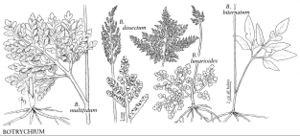Difference between revisions of "Botrychium biternatum"
Bot. Gaz. 22: 407. 1896.
FNA>Volume Importer |
imported>Volume Importer |
||
| (7 intermediate revisions by 2 users not shown) | |||
| Line 8: | Line 8: | ||
}} | }} | ||
|common_names=Sparse-lobed grapefern;southern grapefern | |common_names=Sparse-lobed grapefern;southern grapefern | ||
| − | |basionyms={{Treatment/ID/ | + | |special_status={{Treatment/ID/Special_status |
| + | |code=E | ||
| + | |label=Endemic | ||
| + | }} | ||
| + | |basionyms={{Treatment/ID/Basionym | ||
|name=Osmunda biternata | |name=Osmunda biternata | ||
|authority=Savigny | |authority=Savigny | ||
| + | |rank=species | ||
| + | |publication_title=in Lamarck et al., Encycl. | ||
| + | |publication_place=4: 650. 1797 | ||
}} | }} | ||
|synonyms={{Treatment/ID/Synonym | |synonyms={{Treatment/ID/Synonym | ||
|name=Botrychium dissectum var. tenuifolium | |name=Botrychium dissectum var. tenuifolium | ||
|authority=(L.Underwood) Farwell | |authority=(L.Underwood) Farwell | ||
| − | }}{{Treatment/ID/Synonym | + | |rank=variety |
| + | }} {{Treatment/ID/Synonym | ||
|name=Botrychium tenuifolium | |name=Botrychium tenuifolium | ||
|authority=L.Underwood | |authority=L.Underwood | ||
| + | |rank=species | ||
}} | }} | ||
|hierarchy=Ophioglossaceae;Botrychium;Botrychium subg. Sceptridium;Botrychium sect. Sceptridium;Botrychium biternatum | |hierarchy=Ophioglossaceae;Botrychium;Botrychium subg. Sceptridium;Botrychium sect. Sceptridium;Botrychium biternatum | ||
| Line 26: | Line 35: | ||
}}<!-- | }}<!-- | ||
| − | --><span class="statement" id="st- | + | --><span class="statement" id="st-undefined" data-properties=""><b>Trophophore </b>stalk 4–20 cm, 2–2.5 times length of trophophore rachis; blade green to dark green, plane, 2–3-pinnate, to 18 × 28 cm, herbaceous. <b>Pinnae</b> to 7 pairs, usually remote, horizontal, distance between 1st and 2d pinnae not or slightly more than between 2d and 3d pairs, undivided except in proximal 2/3–1/2. <b>Pinnules</b> elongate, obliquely lanceolate to narrowly lanceolate, margins nearly parallel and finely denticulate, apex short-acuminate, venation pinnate. <b>Sporophores</b> 1–2-pinnate, 2–3 times length of trophophore. <b>2n</b> =90.</span><!-- |
-->{{Treatment/Body | -->{{Treatment/Body | ||
| + | |phenology=Leaves green over winter, sporophores seasonal, new leaves appearing in late spring–early summer. | ||
|habitat=Frequent in low woods and brushy fields | |habitat=Frequent in low woods and brushy fields | ||
|elevation=0–600 m | |elevation=0–600 m | ||
|distribution=Ala.;Ark.;Del.;Fla.;Ga.;Ill.;Ind.;Ky.;La.;Md.;Miss.;Mo.;N.J.;N.C.;Ohio;Okla.;Pa.;S.C.;Tenn.;Tex.;Va.;W.Va. | |distribution=Ala.;Ark.;Del.;Fla.;Ga.;Ill.;Ind.;Ky.;La.;Md.;Miss.;Mo.;N.J.;N.C.;Ohio;Okla.;Pa.;S.C.;Tenn.;Tex.;Va.;W.Va. | ||
| − | |discussion=<p>Botrychium biternatum often grows with B. dissectum and B. jenmanii. The name B. biternatum was misapplied by L.Underwood to B. lunarioides (W.H. Wagner Jr. 1961).</p> | + | |discussion=<p><i>Botrychium biternatum</i> often grows with <i>B. dissectum</i> and <i>B. jenmanii</i>. The name <i>B. biternatum</i> was misapplied by L.Underwood to <i>B. lunarioides</i> (W.H. Wagner Jr. 1961).</p> |
|tables= | |tables= | ||
|references= | |references= | ||
| Line 41: | Line 51: | ||
-->{{#Taxon: | -->{{#Taxon: | ||
name=Botrychium biternatum | name=Botrychium biternatum | ||
| − | |||
|authority=(Savigny) L. Underwood | |authority=(Savigny) L. Underwood | ||
|rank=species | |rank=species | ||
| Line 48: | Line 57: | ||
|basionyms=Osmunda biternata | |basionyms=Osmunda biternata | ||
|family=Ophioglossaceae | |family=Ophioglossaceae | ||
| + | |phenology=Leaves green over winter, sporophores seasonal, new leaves appearing in late spring–early summer. | ||
|habitat=Frequent in low woods and brushy fields | |habitat=Frequent in low woods and brushy fields | ||
|elevation=0–600 m | |elevation=0–600 m | ||
| Line 54: | Line 64: | ||
|publication title=Bot. Gaz. | |publication title=Bot. Gaz. | ||
|publication year=1896 | |publication year=1896 | ||
| − | |special status= | + | |special status=Endemic |
| − | |source xml=https:// | + | |source xml=https://bitbucket.org/aafc-mbb/fna-data-curation/src/2e0870ddd59836b60bcf96646a41e87ea5a5943a/coarse_grained_fna_xml/V2/V2_762.xml |
|genus=Botrychium | |genus=Botrychium | ||
|subgenus=Botrychium subg. Sceptridium | |subgenus=Botrychium subg. Sceptridium | ||
|section=Botrychium sect. Sceptridium | |section=Botrychium sect. Sceptridium | ||
|species=Botrychium biternatum | |species=Botrychium biternatum | ||
| − | |||
| − | |||
| − | |||
| − | |||
| − | |||
| − | |||
| − | |||
| − | |||
| − | |||
| − | |||
| − | |||
| − | |||
| − | |||
| − | |||
| − | |||
| − | |||
| − | |||
| − | |||
| − | |||
| − | |||
| − | |||
}}<!-- | }}<!-- | ||
-->[[Category:Treatment]][[Category:Botrychium sect. Sceptridium]] | -->[[Category:Treatment]][[Category:Botrychium sect. Sceptridium]] | ||
Latest revision as of 21:25, 5 November 2020
Trophophore stalk 4–20 cm, 2–2.5 times length of trophophore rachis; blade green to dark green, plane, 2–3-pinnate, to 18 × 28 cm, herbaceous. Pinnae to 7 pairs, usually remote, horizontal, distance between 1st and 2d pinnae not or slightly more than between 2d and 3d pairs, undivided except in proximal 2/3–1/2. Pinnules elongate, obliquely lanceolate to narrowly lanceolate, margins nearly parallel and finely denticulate, apex short-acuminate, venation pinnate. Sporophores 1–2-pinnate, 2–3 times length of trophophore. 2n =90.
Phenology: Leaves green over winter, sporophores seasonal, new leaves appearing in late spring–early summer.
Habitat: Frequent in low woods and brushy fields
Elevation: 0–600 m
Distribution

Ala., Ark., Del., Fla., Ga., Ill., Ind., Ky., La., Md., Miss., Mo., N.J., N.C., Ohio, Okla., Pa., S.C., Tenn., Tex., Va., W.Va.
Discussion
Botrychium biternatum often grows with B. dissectum and B. jenmanii. The name B. biternatum was misapplied by L.Underwood to B. lunarioides (W.H. Wagner Jr. 1961).
Selected References
None.
